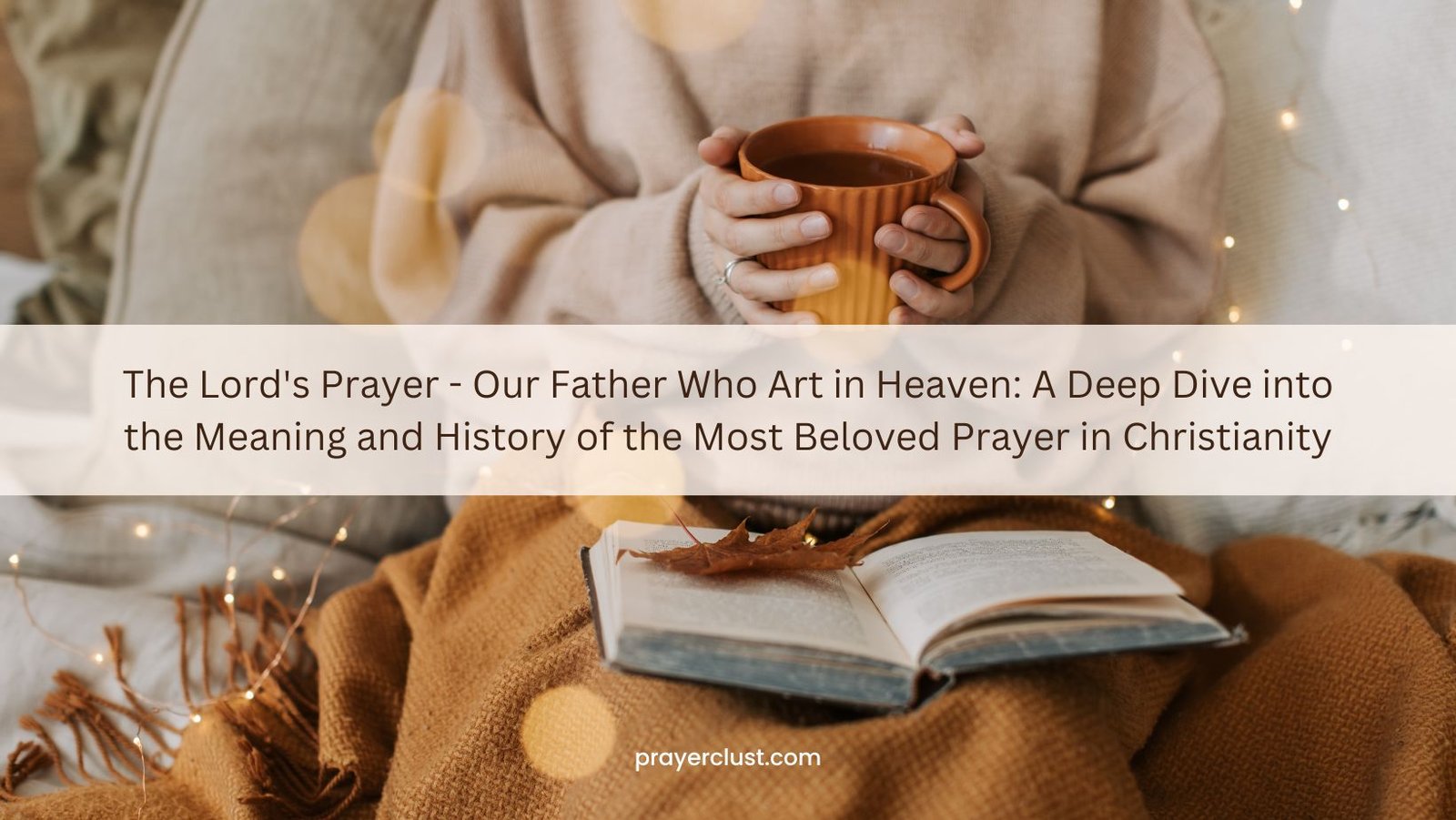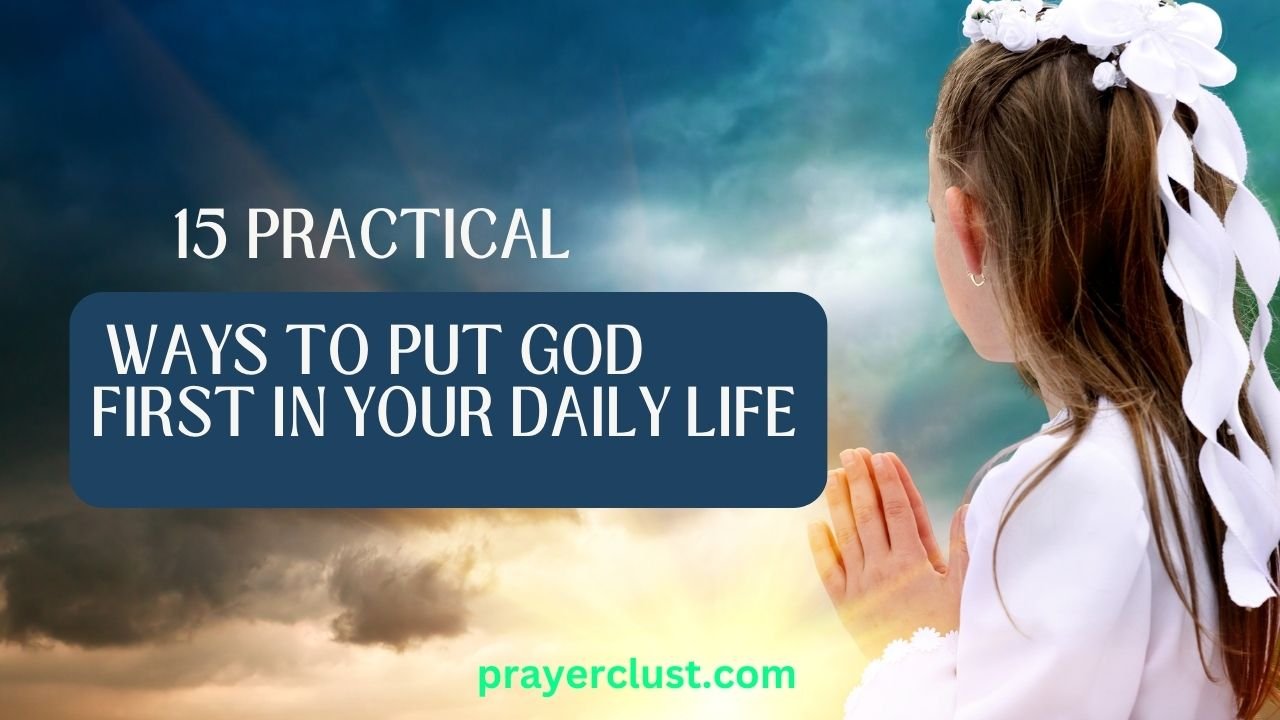The Lord’s Prayer, also known as the Our Father, is the prayer that Jesus Christ taught his disciples when they asked him how to pray. It is one of the most widely recited prayers in the world, and has been translated into hundreds of languages. But what does it mean, and where did it come from? In this blog post, we will explore the origin, meaning, and significance of the Lord’s Prayer, and how it can enrich our spiritual lives today.
The Origin of the Lord’s Prayer
The Lord’s Prayer is found in two places in the New Testament: Matthew 6:9-13 and Luke 11:2-4. The version in Matthew is part of the Sermon on the Mount, where Jesus gives his disciples instructions on various aspects of Christian living, including prayer. The version in Luke is shorter and simpler, and occurs when one of the disciples asks Jesus to teach them to pray, as John the Baptist taught his followers
Both versions of the Lord’s Prayer are based on Jewish prayers that were common in the first century. For example, the opening address “Our Father who art in heaven” echoes the beginning of many Jewish prayers, such as the Kaddish and the Amidah. The phrase “hallowed be thy name” reflects the Jewish reverence for God’s name, which was considered too sacred to be pronounced.
The petition “thy kingdom come” expresses the Jewish hope for the coming of God’s reign on earth, as foretold by the prophets. The request “give us this day our daily bread” resembles a line from Proverbs 30:8, where the wise man asks God for neither poverty nor riches, but only for his daily needs. The plea “forgive us our debts, as we forgive our debtors” recalls the Jewish practice of forgiving others before asking God for forgiveness, especially on the Day of Atonement. The final appeal “lead us not into temptation, but deliver us from evil” reflects the Jewish awareness of human weakness and dependence on God’s protection from sin and evil.
The Lord’s Prayer is not a direct quotation from Jesus, but a summary of his teaching on prayer that was preserved by his followers. The differences between Matthew and Luke show that there was some variation in how the prayer was transmitted and remembered by different Christian communities. However, both versions convey the same essential message: that prayer is a way of aligning ourselves with God’s will and seeking his help for our daily needs and challenges.
The Meaning of the Lord’s Prayer
The Lord’s Prayer is not only a historical document, but also a living prayer that can guide and inspire us today. It contains seven petitions or requests that address different aspects of our relationship with God and with others.

Here is a brief explanation of each petition and its significance for us:
- Our Father who art in heaven: This petition acknowledges that God is our loving Father who cares for us as his children. It also reminds us that God is transcendent and holy, and that we should approach him with reverence and awe. By saying “our” Father, we also affirm that we are part of a larger family of God that includes all believers1.
- Hallowed be thy name: This petition expresses our desire to honor and glorify God’s name in everything we do and say. It also implies that we want to know God more intimately and personally, as he reveals himself to us through his name.
- Thy kingdom come: This petition declares our hope for God’s kingdom to be fully established on earth, where his justice, peace, and love will reign supreme. It also implies that we want to be part of God’s kingdom work, by living according to his values and sharing his gospel with others.
- Thy will be done on earth as it is in heaven: This petition affirms our submission to God’s will and plan for our lives and for the world. It also implies that we want to discern and follow God’s will in every situation, even when it is difficult or contrary to our own preferences.
- Give us this day our daily bread: This petition asks God to provide for our physical needs, such as food, clothing, shelter, health, etc. It also implies that we trust God to give us what we need, not what we want or crave and that we are grateful for his provision.
- Forgive us our debts, as we forgive our debtors: This petition requests God to forgive our sins and mistakes, as we have forgiven those who have wronged us. It also implies that we acknowledge our need for God’s mercy and grace and that we are willing to extend the same forgiveness to others.
- Lead us not into temptation, but deliver us from evil: This petition seeks God’s guidance and protection from the temptations and trials that we face in our daily lives. It also implies that we recognize our vulnerability and weakness and that we rely on God’s strength and power to overcome sin and evil.
- For Yours is the kingdom and the power and the glory forever. Amen: We affirm that God is the king, the ruler, and the owner of everything. We also acknowledge that he has the power, the authority, and the ability to do all things. We also give him the glory, the honor, and the praise for all that he is and all that he does. We end with “Amen”, which means “so be it” or “let it be”.
The Lord’s Prayer consists of seven petitions or requests to God, each one expressing a different aspect of our relationship with him and our needs as his children. Here is a line-by-line analysis of the Lord’s Prayer, based on the MEV version.
The Significance of the Lord’s Prayer
The Lord’s Prayer is not only a model of how to pray but also a summary of what to pray for. It covers the most important aspects of our spiritual life: our relationship with God, our relationship with others, and our relationship with ourselves. It teaches us to balance our prayers between praise and petition, between adoration and supplication, and between worship and intercession.
The Lord’s Prayer is also a way of connecting with the Christian tradition and community. It is a prayer that has been prayed by millions of Christians throughout history and across the world. It is a prayer that unites us with the body of Christ, as we join our voices and hearts with his in seeking God’s will and glory.
The Lord’s Prayer is not a magic formula or a rigid ritual, but a dynamic and flexible prayer that can be adapted to different contexts and circumstances. It can be prayed individually or corporately, silently or aloud, slowly or quickly, verbatim or paraphrased, in any language or translation. It can be used as a complete prayer or as a starting point for further prayer. It can be prayed at any time or place, but especially at the beginning or end of the day, before or after meals, in times of joy or sorrow, in times of need or abundance.
The Lord’s Prayer is a gift from Jesus to his followers, a gift that keeps on giving. It is a prayer that can enrich our spiritual lives, deepen our faith, strengthen our hope, and increase our love. It is a prayer that can transform us and the world around us. It is a prayer that can bring us closer to God and to his kingdom.
6 Steps Taught in the Lord’s Prayer: How to Pray Like Jesus
Prayer is one of the most important practices of the Christian faith. It is a way of communicating with God, expressing our gratitude, asking for help, confessing our sins, and aligning our will with his. But how do we pray? What should we say to God? How can we make our prayers more meaningful and effective?
Fortunately, we have a perfect example and guide from Jesus himself. In the Bible, we find two occasions where Jesus taught his disciples how to pray. He gave them a simple but profound prayer that covers every aspect of our relationship with God and our needs as his children. This prayer is known as the Lord’s Prayer, or the Our Father.
In this blog post session, we will explore the steps taught in the Lord’s Prayer, and how we can apply them to our own prayer lives. We will also look at some of the benefits and challenges of following this prayer model. By the end of this session, we hope that you will have a deeper understanding and appreciation of the Lord’s Prayer, and that you will be able to pray like Jesus.
Step 1: Address God as Our Father
The first step in the Lord’s Prayer is to address God as our Father. This shows that we have a personal and intimate relationship with God, who loves us and cares for us as his children. It also shows that we are part of a larger family of God, who share the same Father and the same faith.
When we call God our Father, we acknowledge that he is the source of our life, our identity, and our inheritance. We also recognize that he is in heaven, which means he is transcendent, holy, and sovereign over all creation.
Some questions to reflect on this step are:
- How do you feel about calling God your Father? What does it mean to you?
- How does addressing God as your Father affect your attitude and approach to prayer?
- How can you cultivate a closer relationship with God as your Father?
Step 2: Praise God for His Name
The second step in the Lord’s Prayer is to praise God for his name. This means that we honor, respect, and glorify God for who he is and what he has done. His name represents his character, his attributes, and his actions. Some of the names of God in the Bible are:
- Yahweh: The personal name of God, which means “I am who I am” (Exodus 3:14).
- Elohim: The generic name of God, which means “God” or “gods” (Genesis 1:1).
- Adonai: The lordship name of God, which means “Lord” or “Master” (Genesis 15:2).
- El Shaddai: The almighty name of God, which means “God Almighty” or “God All-Sufficient” (Genesis 17:1).
- Jehovah Jireh: The provision name of God, which means “The Lord Will Provide” (Genesis 22:14).
- Jehovah Rapha: The healing name of God, which means “The Lord Who Heals” (Exodus 15:26).
- Jehovah Nissi: The victory name of God, which means “The Lord Is My Banner” (Exodus 17:15).
- Jehovah Shalom: The peace name of God, which means “The Lord Is Peace” (Judges 6:24).
- Jehovah Rohi: The shepherd name of God, which means “The Lord Is My Shepherd” (Psalm 23:1).
- Jehovah Tsidkenu: The righteousness name of God, which means “The Lord Is Our Righteousness” (Jeremiah 23:6).
- Jehovah Shammah: The presence name of God, which means “The Lord Is There” (Ezekiel 48:35).
When we praise God for his name, we express our gratitude, admiration, and awe for him. We also declare his greatness and majesty to ourselves and to others.
Some questions to reflect on this step are:
- What are some of the names of God that you know and love? What do they reveal about him?
- How do you praise God for his name in your prayers? How does it affect your view of him?
- How can you learn more about the names of God and their meanings?
Step 3: Acknowledge God’s Kingdom and Will
The third step in the Lord’s Prayer is to acknowledge God’s kingdom and will. This means that we express our desire for God’s rule, justice, and peace to be established on earth as it is in heaven. It also means that we submit to God’s plan, purpose, and commandments for our lives.
When we acknowledge God’s kingdom and will, we align ourselves with his vision and values. We also surrender our own preferences and agendas to him. We trust that he knows what is best for us and for the world, and that he will accomplish it in his way and in his time.
Some questions to reflect on this step are:
- What does God’s kingdom look like to you? How do you see it manifested in your life and in the world?
- What is God’s will for you? How do you discern it and follow it?
- How do you cope with the tension between God’s will and your will? How do you handle the situations where they seem to conflict?
Step 4: Ask God for Our Needs
The fourth step in the Lord’s Prayer is to ask God for our needs. This means that we request God to provide for our physical, emotional, mental, and spiritual needs. We also acknowledge that he is the source of everything we have and everything we need.
When we ask God for our needs, we demonstrate our dependence on him and our confidence in him. We also recognize that he is generous, faithful, and attentive to us. We trust that he will give us what we need for each day, without worrying about tomorrow.
Some questions to reflect on this step are:
- What are some of the needs that you have right now? How do you ask God for them?
- How do you balance your requests with your contentment? How do you deal with the answers that God gives you?
- How can you be more aware of God’s provision and presence in your life?
Step 5: Confess Our Sins and Forgive Others
The fifth step in the Lord’s Prayer is to confess our sins and forgive others. This means that we admit our mistakes, failures, and offenses to God and to others. We also ask for his forgiveness and his help to change. We also extend the same forgiveness and grace to those who have hurt us or wronged us in any way.
When we confess our sins and forgive others, we experience God’s mercy and healing. We also restore our relationship with him and with others. We free ourselves from the burden of guilt, shame, anger, and bitterness.
Some questions to reflect on this step are:
- What are some of the sins that you struggle with or need to confess? How do you approach God with them?
- How do you receive God’s forgiveness and assurance? How does it affect your self-image and your behavior?
- Who are some of the people that you need to forgive or ask for forgiveness? How do you go about it?
Step 6: Request God’s Protection and Guidance
The sixth and final step in the Lord’s Prayer is to request God’s protection and guidance. This means that we ask God to shield us from temptation, which is anything that can lure us away from him or from doing what is right. We also ask him to deliver us from evil, which is anything that can harm us or hinder us from fulfilling his will.
When we request God’s protection and guidance, we acknowledge our weakness and vulnerability. We also recognize his strength and wisdom. We rely on his power and presence to help us overcome the challenges and difficulties that we face.
Some questions to reflect on this step are:
- What are some of the temptations that you face or need to avoid? How do you resist them or flee from them?
- What are some of the evils that you encounter or need to overcome? How do you fight them or escape from them?
- How do you sense God’s protection and guidance in your life? How does it affect your courage and confidence?

Final Thoughts
The Lord’s Prayer is the most beloved prayer in Christianity, because it is the prayer that Jesus himself taught us. It is a prayer that reflects his heart and mind, his vision and mission, his grace and truth. It is a prayer that invites us to share in his intimacy with the Father, his passion for the kingdom, his compassion for the people, his victory over sin and evil. It is a prayer that challenges us to grow in our knowledge and love of God, in our service and witness to others, in our obedience and faithfulness to his will.
The Lord’s Prayer is not just words that we recite, but words that we live by. It is not just a prayer that we say, but a prayer that we do. It is not just a prayer that we pray, but a prayer that prays us.
May the Lord’s Prayer be our daily prayer, our constant companion, our faithful guide. May it be the prayer of our lips and the prayer of our lives. Amen.






